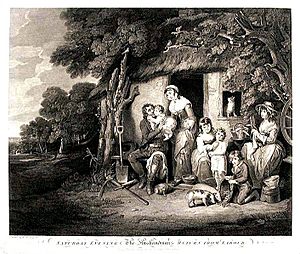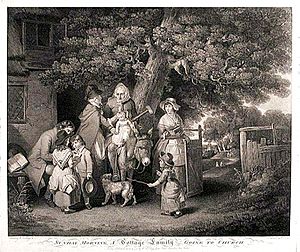William Redmore Bigg facts for kids
William Redmore Bigg was a British painter who lived from 1755 to 1828. He was known for his charming paintings, especially those showing children and everyday country life. He became a member of the Royal Academy, a famous art institution in London.
Contents
Meet William Redmore Bigg
William Redmore Bigg was born in a place called Felsted in Essex, England, on January 6, 1755. His parents were William and Grace Bigg. He grew up to become a talented artist.
His Art School Days
In 1778, William Bigg started studying art at the Royal Academy schools. There, he learned from a painter named Edward Penny. Penny was known for painting scenes about helping others. This might have influenced Bigg's own style.
What Kind of Art Did He Make?
Bigg really loved painting children. His first painting shown in public, in 1778, was called Schoolboys giving Charity to a Blind Man. This painting showed kids being kind and helpful. A year later, he painted a similar picture, A Lady and her Children relieving a Distressed Cottager. This one also showed people helping someone in need.
Some of his other popular paintings included Palemon and Lavinia, the Shipwrecked Sailor Boy, and Youths relieving a Blind Man. People liked these paintings so much that they were made into prints, which meant more people could see and own them. Bigg's style was similar to other artists of his time, like Francis Wheatley and George Morland.
Besides these bigger scenes, Bigg also painted many smaller portraits. These were often done using oil paints or pastels. He also created many "rustic genre" paintings. These showed simple, everyday life in the countryside. His paintings were very popular when he was alive. The best engravers (artists who make prints from paintings) worked on his art.
His Art Shows and Recognition
William Bigg regularly showed his paintings at important art exhibitions. He displayed his work at the Royal Academy and the British Institution. He kept showing his art until he passed away. After being an associate member for many years, he was chosen to be a full Royal Academician (RA) in 1814. This was a big honor for an artist. He died in London on February 6, 1828.



